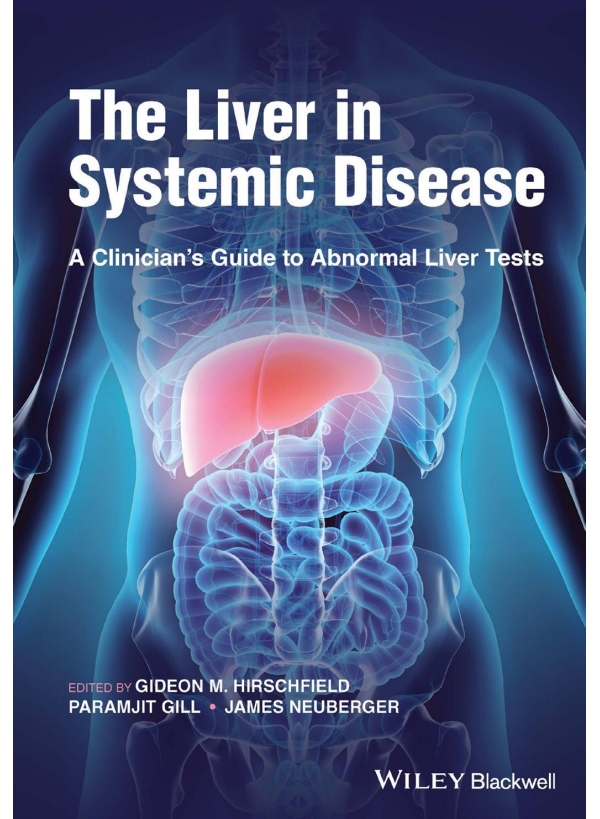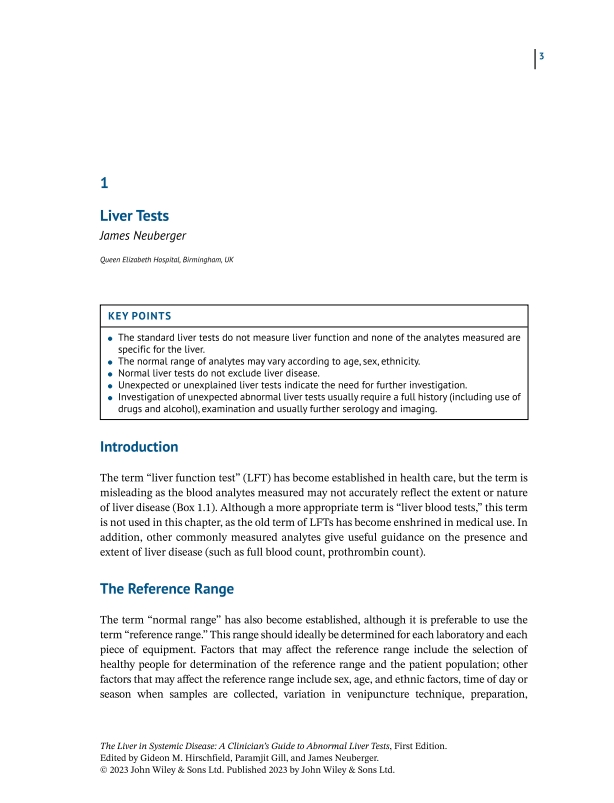


您可以复制以下内容进行翻译:
Part.1
LiverTests
James Neuberger
Queen Elizabeth HospitaL,Binmingham, UK
KEY POINTS
he standard liver tests do not measure liver function and none of the analytes measured are specific for the liver.
The normal range of analytes may vary according to age,sex,ethnicity.
Normal liver tests do not exclude liver disease.
Unexpected or unexplained liver tests indicate the need for further investigation.
Investigation of unexpected abnormal liver tests usually require a full history (including use ofdrugs and alcohol),examination and usually further serology and imaging.
Introduction
The term “liver function test” (LFT) has become established in health care, but the term is
misleading as the blood analytes measured may not accurately reflect the extent or nature
of liver disease (Box 1.1). Although a more appropriate term is “liver blood tests,? this term
is not used in this chapter, as the old term of LFTs has become enshrined in medical use. In
addition, other commonly measured analytes give useful guidance on the presence and
extent of liver disease (such as full blood count, prothrombin count).
The Reference Range
The term “normal range" has also become established, although it is preferable to use the
term “reference range." This range should ideally be determined for each laboratory and each
piece of equipment. Factors that may affect the reference range include the selection of
healthy people for determination of the reference range and the patient population; other
factors that may affect the reference range include sex, age, and ethnic factors, time of day or
season when samples are collected, variation in venipuncture technique, preparation,
The Liver in Systemic Disease: A Clinician's Guide to Abnormal Liver Tests, First Edition.
Edited by Gideon M. Hirschfield, Paramjit Gill, and James Neuberger.
@ 2023 John Wiley & Sons Ltd. Published 2023 by John Wiley & Sons Ltd.
中文草稿
肝功能检查
詹姆斯·纽伯格
英国伯明翰伊丽莎白女王医院
要点
– 标准肝功能检查并非衡量肝脏功能,所检测的分析物没有一种是肝脏特有的。
– 分析物的正常范围可能因年龄、性别、种族而异。
– 肝功能检查正常并不能排除肝脏疾病。
– 异常或无法解释的肝功能检查结果表明需要进一步检查。
– 对异常肝功能检查结果进行调查通常需要详细的病史(包括药物和酒精使用情况)、体格检查,通常还需要进一步的血清学检查和影像学检查。
引言
“肝功能检查”(LFT)这一术语在医疗保健领域已被广泛使用,但这个术语具有误导性,因为所检测的血液分析物可能无法准确反映肝脏疾病的程度或性质(方框1.1)。尽管“肝脏血液检查”是更合适的术语,但本章不使用该术语,因为“肝功能检查”这一旧术语已在医学实践中根深蒂固。此外,其他常用的检测分析物对肝脏疾病的存在及程度也能提供有用的指导(如全血细胞计数、凝血酶原计数)。
参考范围
“正常范围”这一术语也已被广泛使用,不过使用“参考范围”这一术语更为合适。理想情况下,每个实验室和每件设备都应确定各自的参考范围。可能影响参考范围的因素包括确定参考范围时对健康人群的选择以及患者群体;其他可能影响参考范围的因素包括性别、年龄、种族因素、采集样本的时间(一天中的时间或季节)、静脉穿刺技术的差异、样本制备等。
《全身性疾病中的肝脏:异常肝功能检查临床医生指南》第一版
吉迪恩·M·赫希菲尔德、帕拉姆吉特·吉尔、詹姆斯·纽伯格 编著
© 2023 约翰·威利父子有限公司。2023年由约翰·威利父子有限公司出版
Part.2
Box1.1Characteristics of Liver Blood Tests
Not liver specific● Do not measure function
Not tests
● May be within normal Limits when there is severe liver disease
● May be abnormal when the liver is structurally or functionally normal
● Normal ranges will vary:
-between laboratories
-with age
-with sex
-with ethnicity
-with normal physiology (such as pregnancy)
● Not diagnostic for any specific liver disease
● Results in the high normal range may be associated with an increased risk of death
storage, and analysis of samples. The reference range should be established by testing at least
120 samples (although many regulatory bodies suggest a higher number) and clear outliers
are usually excluded. The reference range may be determined by one of two approaches:
1) The parametric approach can be used only when the distribution of values falls within a
normal distribution; the reference range lies within the 95% confidence interval.
2) The non-parametric approach defines the reference range as lying between the 2.5 and
97.5 percentiles of the population.
Whichever approach is adopted, the implication is that, for healthy individuals, around
5% samples will have values lying outside the reference range. In some cases, such as blood
sugar or triglycerides, the reference range is determined more by consensus than the pro-
cess outlined above.
When abnormal tests are reported, further investigations should be undertaken, the
nature and extent will depend on the clinical situation. A guide to further management of
abnormal liver tests is given in Box 1.2. This will help to define the presence (if any) of liver
disease, the extent of liver damage, and the cause of the abnormal liver tests and, where
appropriate, the response to treatment. A clinician needs to understand the several tests
available to assess liver function and causes of liver disease and the limitation of these tests.
TheStandard LiverFunctionTests
Analytes measured in the battery of LFTs include:
●albumin
● aspartate amino transferase (AST)
● alanine amino transferase (ALT)
● alkaline phosphatase (AP)
● gamma-glutamyl transferase (GGT).
中文草稿
1.1 肝脏血液检查的特点**
– **并非肝脏特异性**:不检测肝脏功能
– **并非真正意义的功能测试**:
– 严重肝病时,检测结果可能在正常范围内。
– 肝脏结构或功能正常时,检测结果可能异常。
– **正常范围会有所不同**:
– 不同实验室之间有差异。
– 因年龄而异。
– 因性别而异。
– 因种族而异。
– 因正常生理状态(如妊娠)而异。
– **对任何特定肝病均无诊断性**:
– 处于正常范围高值的检测结果,可能与死亡风险增加相关。
样本的储存与分析也会影响参考范围。参考范围应通过检测至少120个样本确定(尽管许多监管机构建议检测更多样本),明显的异常值通常会被排除。参考范围可通过以下两种方法之一确定:
1. **参数法**:仅当数值分布符合正态分布时才可使用;参考范围在95%置信区间内。
2. **非参数法**:将参考范围定义为人群数值的第2.5百分位数到第97.5百分位数之间。
无论采用哪种方法,这意味着对于健康个体,约5%的样本数值会超出参考范围。在某些情况下,如血糖或甘油三酯,参考范围更多是通过共识确定,而非上述过程。
当报告检测结果异常时,应进行进一步检查,检查的性质和范围将取决于临床情况。方框1.2给出了异常肝功能检查进一步处理的指南。这将有助于确定是否存在(若存在)肝病、肝损伤程度、肝功能检查异常的原因,以及在适当情况下,对治疗的反应。临床医生需要了解可用于评估肝功能和肝病病因的几种检查方法,以及这些检查的局限性。
标准肝功能检查
肝功能检查系列中检测的分析物包括:
– 白蛋白
– 天冬氨酸氨基转移酶(AST)
– 丙氨酸氨基转移酶(ALT)
– 碱性磷酸酶(AP)
– γ-谷氨酰转移酶(GGT)